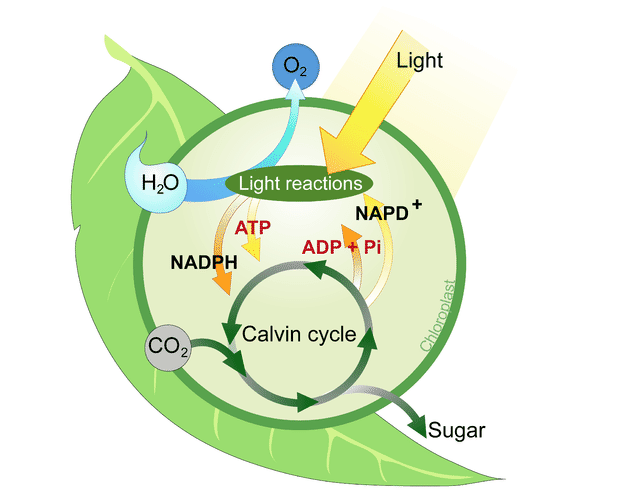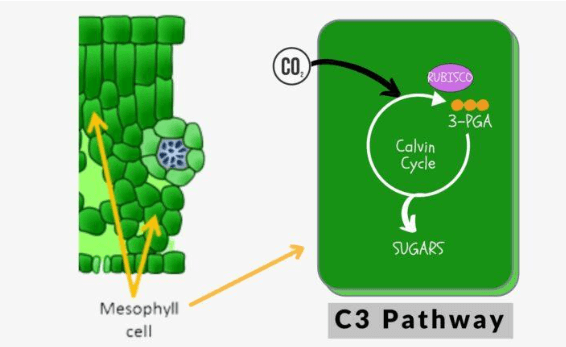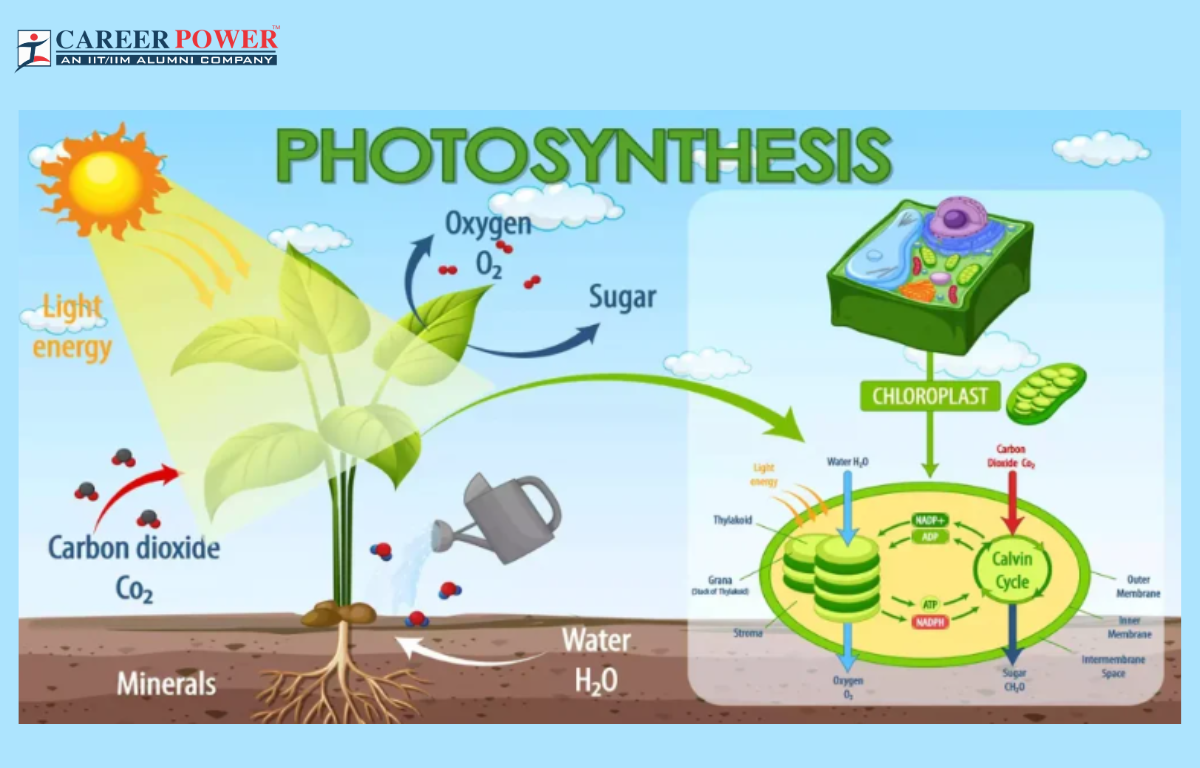As we all are very well known to the most important topic of biology i.e., “Photosynthesis”. Normally Photosynthesis is the process by which plants, convert the light energy of the sun into chemical energy stored in glucose and other organic compounds. It takes place in the chloroplast of the plant cells, primarily in the leaves. Chlorophyll, the green pigment in plants, captures sunlight and initiates the conversion of carbon dioxide and water into glucose and oxygen through a series of complex biochemical reactions. This mechanism supports the development of plants and emits oxygen into the air.
The process of photosynthesis we studied till now was the process involved in smaller plants. So now let us discuss the same process of photosynthesis in higher plants and see whether the process of photosynthesis is the same in both higher and smaller plants.
Photosynthesis in Higher Plants
Photosynthesis in higher plants is not that much different from photosynthesis in smaller plants. Photosynthesis in higher plants only involves some additional steps or processes. As higher plants also convert the light energy of the sun into chemical energy stored in glucose and other organic compounds.
Photosynthesis is the fundamental process that occurs in all plants, regardless of size. The basic principles of photosynthesis are the same in both higher plants (larger, more complex plants) and smaller plants. However, there might be some differences in terms of efficiency, adaptations, and specific strategies due to their size and environmental conditions.

Processes Involved in Photosynthesis in Higher Plants
Photosynthesis in higher plants is a complex process that involves capturing light energy, and converting it into chemical energy (ATP and NADPH), using that energy to fix carbon dioxide, and ultimately producing necessary for the plant’s survival and growth. Photosynthesis in higher plants involves two main sets of processes: light reactions and dark reactions (also known as the Calvin Cycle).
| Processes Involved in Photosynthesis in Higher Plants | |
| Processes | Description |
| Light Reaction | The light reaction occurs in chloroplast’s thylakoid membranes, using light to split water, form ATP, NADPH, and oxygen. |
| Dark Reaction | The Dark reactions occur in the chloroplast’s stroma and use ATP, NADPH, and carbon dioxide to produce glucose and other sugars essential for plant growth. It involves two cycles: the Calvin cycle and Hatch and Slack Pathway |
Light Reaction
The thylakoid membranes within chloroplasts are where the light-dependent reactions of photosynthesis take place. They involve the absorption of light by chlorophyll and other pigments. This excites electrons, initiating a chain of events that results in the splitting of water molecules (Photolysis), releasing oxygen, protons, and electrons. The excited electrons move through the protein complexes, creating a proton gradient across the thylakoid membrane.
This gradient tells us about the synthesis of ATP through ATP synthase. Simultaneously, electrons combine with NADP+ to form NADPH. These energy-rich molecules, ATP and NADPH, are crucial for the subsequent dark reactions where carbon dioxide is fixed and glucose is produced.
The Light Reaction Steps
The light reaction in photosynthesis in higher plants involves several steps: Photon Absorption, Water splitting, Electron transport chain, ATP, and NADPH formation. Now let us understand all these steps properly.
- Photon Absorption: Light energy is absorbed by pigments, primarily chlorophyll, in the thylakoid membranes.
- Water Splitting: Water molecules are split through a process called photolysis, releasing oxygen, protons (H+), and electrons.
- Electron Transport Chain: Electrons released from water molecules move through a series of protein complexes in the thylakoid membrane. As electrons move, protons are pumped across the membrane creating a proton gradient.
- ATP and NADPH Formation: The energy from the electron transport chain is used to pump protons into the thylakoid space. the protons move back into the stroma through ATP synthase, resulting in the creation of ATP. NADP+ combines with the electrons for the formation of NADPH.
Photophosphorylation
Photophosphorylation is the process in photosynthesis where light energy is used to convert inorganic phosphate into ATP (adenosine triphosphate), a molecule that stores and transfers energy within the cells. This process occurs in the thylakoid membrane of the chloroplasts and is a crucial step in the production of energy-rich compounds during photosynthesis in higher plants.
There are two main types of photophosphorylation: Cyclic and Non-Cyclic. Both types of photophosphorylation are essential for providing the energy needed to convert carbon dioxide and water into glucose and other organic molecules during the process of photosynthesis.
- Non-Cyclic Photophosphorylation: In this type of photophosphorylation, light energy is used to generate both ATP and NADPH (a coenzyme involved in energy transfer) by a series of complex reactions involving two photosystems (photosystem I and photosystem II) and an electron transport chain. Oxygen is released as a byproduct during this reaction.
- Cyclic Photophosphorylation: This process only involves photosystem I and an electron transport chain. It generates ATP without producing NADPH or releasing oxygen. Electrons are cycled back to the photosystem, allowing for continuous ATP production.
Dark Reaction
The dark reaction is the second phase of photosynthesis that takes place in the stroma of the chloroplast. In this process, carbon dioxide from the atmosphere is used to synthesize glucose and other organic molecules. The ATP and NADPH produced during the light reaction are utilized to power the conversion of carbon dioxide into glucose through a series of enzymatic reactions. This cycle does not directly require light and can occur in the absence of light. The process of Dark reaction involves two very important cycles: the Calvin cycle (C3 Cycle) and Hatch and slack Pathway (C4 Cycle).
Dark Reaction Types
Dark reactions also known as the Calvin cycle or light-independent reactions, are the second phase of photosynthesis. They occur in the stroma of the chloroplasts and involve the conversion of carbon dioxide into glucose. There are two main types of dark reactions: the Calvin cycle and the Hatch and Slack pathway. We have tabulated their description below:
| Cycles Involved in Dark Reaction | |
| Cycles | Description |
| Calvin cycle (C3 Cycle) | Calvin cycle uses ATP and NADPH from light reactions to convert CO2 into glucose. |
| Hatch and Slack Pathway (C4 Cycle) | C4 plants fix CO2 in mesophyll cells and transfer it to bundle sheath cells, enhancing photosynthesis in heat and aridity. |
Calvin Cycle (C3 Cycle)
The Calvin cycle, also called the Calvin-Benson Cycle, is a sequence of chemical reactions that takes place within the chloroplasts of higher plants while undergoing photosynthesis. Its main purpose is to convert carbon dioxide (CO2) from the atmosphere into glucose and other sugars. This process occurs through three phases: Carbon fixation, Reduction, and Regeneration of the initial RuBP molecule. The Calvin cycle utilizes the energy from ATP and NADPH, which are products of the light reactions, to drive the conversion of CO2 into carbohydrates, contributing to the plant’s energy storage and growth. Now let’s discuss the stages of the Calvin Cycle:
- Carbon Fixation: Carbon dioxide from the atmosphere combines with a five-carbon compound called ribulose-1,5-bisphosphate (RuBP) to form a three-carbon compound (3-phosphoglycerate or 3-PGA) with the help of an enzyme called ribulose-1,5-bisphosphate carboxylase/oxygenase (RuBisCO).
- Reduction: During the Reduction phase, the energy-rich compounds ATP and NADPH, generated in the light reactions, are employed to transform 3-PGA molecules into a three-carbon sugar known as glyceraldehyde-3-phosphate (G3P).
- Regeneration of RuBP: Some molecules are used to regenerate RuBP, ensuring the continuation of the Calvin cycle.

Hatch and Slack Pathway (C4 Cycle)
The Hatch-Slack pathway, or C4 pathway, is a photosynthetic adaptation in some plants to minimize water loss and improve efficiency in hot environments. In this process, CO2 first enters specialized mesophyll cells and is converted into a four-carbon compound (C4) using phosphoenolpyruvate carboxylase (PEP carboxylase).
This C4 compound is then transported to bundle sheath cells, where it releases CO2 and enters the Calvin cycle. This separation of CO2 fixation and the Calvin cycle minimizes the wasteful process of photorespiration, enabling efficient carbon fixation even when stomata are partially closed to prevent water loss.
Photorespiration
Photorespiration is a process in higher plants where they “breathe in” oxygen and “breathe out” carbon dioxide, similar to how we do. But in higher plants, this process takes place when there is not enough carbon dioxide available. Photorespiration is like a backup plan that uses up energy and can be inefficient for the plant.
It is considered to be wasteful, as it consumes energy and decreases the efficiency of photosynthesis. This process of photorespiration can be useful in the proper maintenance of the carbon cycle. Now let’s discuss the factors affecting photorespiration:
- Temperature: Higher temperatures generally increase the rate of photorespiration. This is because higher temperatures can cause enzymes, particularly Rubisco, to interact more frequently with oxygen instead of carbon dioxide, leading to more photorespiration.
- Oxygen Concentration: High levels of oxygen relative to carbon dioxide can increase the likelihood of Rubisco interacting with oxygen instead of carbon dioxide, promoting photorespiration.
- Water Stress: Drought or water stress can close the stomata to conserve water, which can lead to an increase in oxygen levels within the leaf and enhance photorespiration.
- Carbon Fixation Pathways: Plants with different carbon fixation pathways, like C3, C4, and CAM plants, exhibit varying degrees of photorespiration. C3 plants are more prone to photorespiration compared to the C4 and CAM plants.
- Genetic Variation: Genetic differences within plants population can affect their susceptibility to photorespiration. Some plants may have naturally higher or lower rates of photorespiration due to genetic variations.
For a detailed study about Photosynthesis in Higher Plants, watch the video given below:



 50 Vegetables Name for Kids in English a...
50 Vegetables Name for Kids in English a...
 Food Chain: Definition, Types, Examples,...
Food Chain: Definition, Types, Examples,...
 Human Respiratory System: Definition, Di...
Human Respiratory System: Definition, Di...













